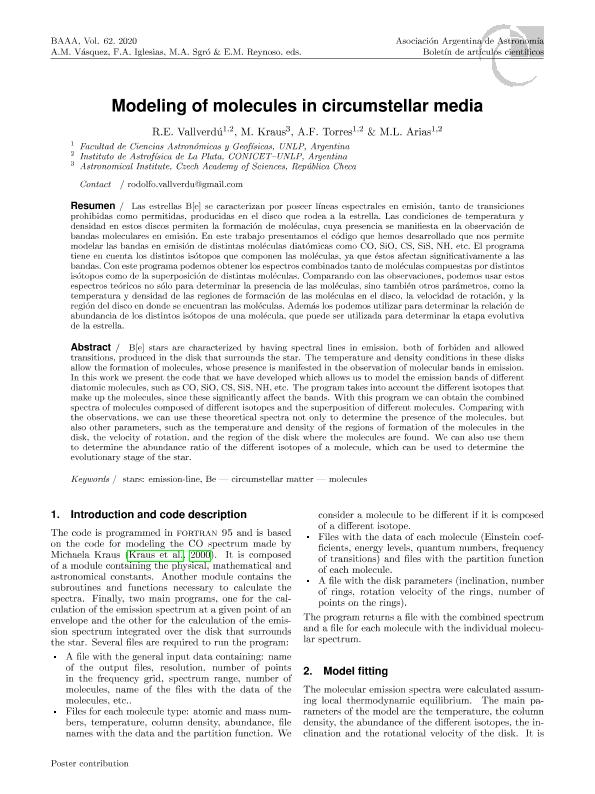Evento
Las estrellas B[e] se caracterizan por poseer lı́neas espectrales en emisión, tanto de transiciones prohibidas como permitidas, producidas en el disco que rodea a la estrella. Las condiciones de temperatura ydensidad en estos discos permiten la formación de moléculas, cuya presencia se manifiesta en la observación de bandas moleculares en emisión. En este trabajo presentamos el código que hemos desarrollado que nos permite modelar las bandas en emisión de distintas moléculas diatómicas como CO, SiO, CS, SiS, NH, etc. El programatiene en cuenta los distintos isótopos que componen las moléculas, ya que éstos afectan significativamente a las bandas. Con este programa podemos obtener los espectros combinados tanto de moléculas compuestas por distintos isótopos como de la superposición de distintas moléculas. Comparando con las observaciones, podemos usar estosespectros teóricos no sólo para determinar la presencia de las moléculas, sino también otros parámetros, como la temperatura y densidad de las regiones de formación de las moléculas en el disco, la velocidad de rotación, y la región del disco en donde se encuentran las moléculas. Además los podemos utilizar para determinar la relación de abundancia de los distintos isótopos de una molécula, que puede ser utilizada para determinar la etapa evolutiva de la estrella. B[e] stars are characterized by having spectral lines in emission, both of forbiden and allowed transitions, produced in the disk that surrounds the star. The temperature and density conditions in these disks allow the formation of molecules, whose presence is manifested in the observation of molecular bands in emission. In this work we present the code that we have developed which allows us to model the emission bands of different diatomic molecules, such as CO, SiO, CS, SiS, NH, etc. The program takes into account the different isotopes that make up the molecules, since these significantly affect the bands. With this program we can obtain the combined spectra of molecules composed of different isotopes and the superposition of different molecules. Comparing with the observations, we can use these theoretical spectra not only to determine the presence of the molecules, but also other parameters, such as the temperature and density of the regions of formation of the molecules in the disk, the velocity of rotation, and the region of the disk where the molecules are found. We can also use them to determine the abundance ratio of the different isotopes of a molecule, which can be used to determine the evolutionary stage of the star.
Modeling of molecules in circumstellar media
Tipo del evento:
Reunión
Nombre del evento:
62° Reunión Anual de la Asociación Argentina de Astronomía
Fecha del evento:
10/2020
Institución Organizadora:
Asociación Argentina de Astronomía;
Título de la revista:
Boletín de la Asociación Argentina de Astronomía
Editorial:
Asociación Argentina de Astronomía
ISSN:
1669-9521
Idioma:
Inglés
Clasificación temática:
Resumen
Palabras clave:
stars: emission-line, Be
,
circumstellar matter
,
molecules
Archivos asociados
Licencia
Identificadores
Colecciones
Eventos(IALP)
Eventos de INST.DE ASTROFISICA LA PLATA
Eventos de INST.DE ASTROFISICA LA PLATA
Citación
Modeling of molecules in circumstellar media; 62° Reunión Anual de la Asociación Argentina de Astronomía; Argentina; 2020; 1-3
Compartir




